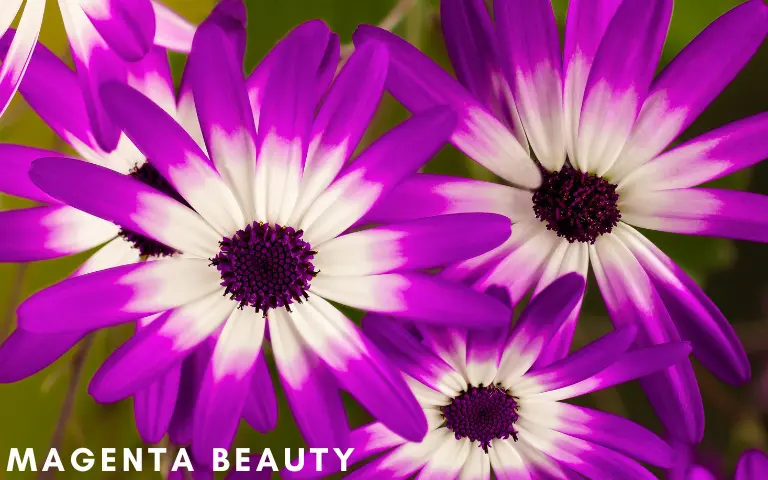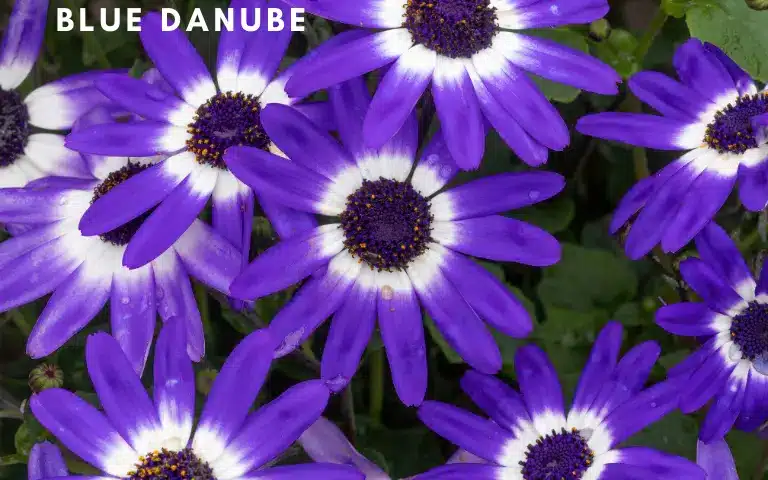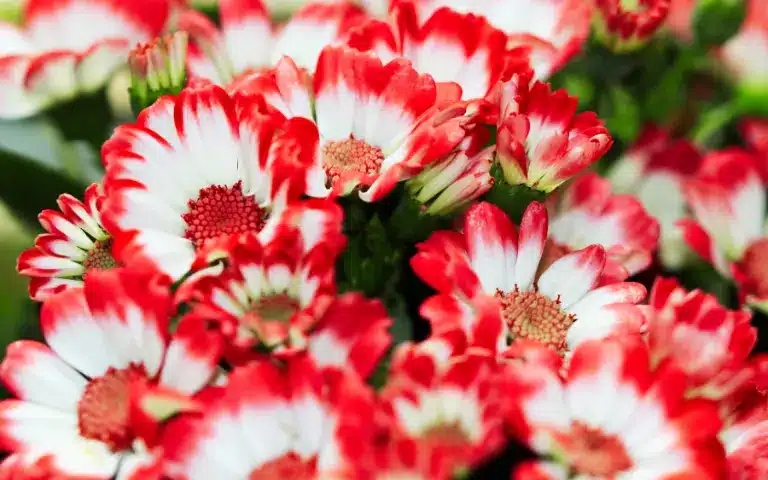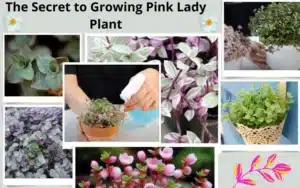Watch a Senetti plant at sunset. The light seems to just glow from those flowers, especially those with the white or peach centers. These beautiful, vibrant daisy-like flowers come in a range of colors like violets, blues, and magentas. You’ll find unique varieties like the violet bicolor, light blue bicolor, and even a stunning burgundy.
It’s like a burst of color that wakes up your garden after a long winter.
All About Senetti Plants
You know those spring flowers in garden centres? Senetti plants are a UK gardener’s favourite!
Where do senetti plant come from?
These plants are from the Canary Islands, a group of volcanic islands off the coast of Africa. The Canary Islands have a sunny climate, which is perfect for these plants.
Name and history
This plant’s name has a pretty interesting history. It used to be called a Senecio. But then it changed to Cineraria, and then again to Senetti. The “Senetti” name is actually a registered trademark for a specific variety, not the plant itself. And guess what? It’s actually a Pericallis!
The scientific name for Senetti plants is Pericallis × hybrida. You might see that on a plant tag, but most people just call them Senetti. They became popular in the UK after new hybrids with amazing colours and flower shapes were created.
Why senetti is perfect for spring?
Senetti plants thrive in cool temperatures, making them perfect for the spring season. They’ll happily bloom anywhere from freezing to around 80-90 degrees Fahrenheit. As the weather warms up, their flower production will start to slow down.
How to propagate senetti?
One cool thing about Senetti is that it doesn’t reseed. It’s propagated from cuttings, which is why you see so many unique colors and varieties.
A rainbow of senetti varieties:
Senetti plants come in many colours. You’ll see pinks, purples, blues, reds, whites and bi-colours. They have bright, daisy-like flowers.
Senetti plants have special leaves. It’s usually dark green and fuzzy, giving it a nice texture. Here are some of the most popular Senetti varieties:



- Blue Danube: This variety has beautiful, sky-blue blooms.
- Magenta Beauty: It’s hard to miss these plants with their rich magenta flowers.
- Rainbow Mix: If you love variety, this mix features a kaleidoscope of colors.
- White Symphony: This variety features a beautiful white flower with a contrasting yellow center.
When choosing a Senetti plant, you can find different sizes, from small pots to larger container plants. Think about where you’ll plant it and choose a variety that fits your space.
Do you have a favorite Senetti variety? Let me know in the comments!
Senetti and pansies:
Since Senetti has similar care requirements to pansies, you can easily grow them together.
Combining senetti with other plants:
Senetti pairs beautifully with other plants. You can combine them with planaria or winter stems like dogwood or curly willow. They’ll also work well with cool-season vegetables.
Is Senetti Plant a Perennial?
Nope, Senetti plants aren’t true perennials in the UK climate.
Why not?
Senetti plants are very sensitive to cold temperatures. They’re happiest in those warm, spring days. Once the frost arrives, it can really damage them.
The UK climate:
Senetti don’t usually survive the UK winter. They’re usually planted in spring and enjoyed until it gets colder. But there’s more:
Some gardeners in milder parts of the UK might be able to get their Senetti plants to survive for a second year. It’s tricky and they need extra protection during the winter.
Have you ever tried to overwinter a Senetti plant? Share your experience in the comments!
How Long Do Senetti Plants Last?
Here in the UK, Senetti usually start flowering in the spring and continue blooming throughout the summer. So you’re in for a long, colorful show!
With good care, your Senetti plants can live for several months, enjoying those spring and summer days. They’re a real workhorse of the garden!
Factors that Can Affect Lifespan:
- Weather Conditions: Senetti plants like cool temperatures. Too much heat can shorten their lifespan. Likewise, if we get a sudden cold snap, it can really impact their blooming.
- Soil quality: Senetti plants do best in well-drained soil. If the soil is too wet, it can rot the roots and shorten the plant’s life.
- Pests: Like other plants, Senetti plants can be damaged by pests. Aphids, whitefly and other pests can damage plants and kill them.
Keeping Your Senetti Plants Thriving

To help your Senetti plants thrive for as long as possible, keep an eye on the weather, make sure they have good drainage, and be on the lookout for any pests. Think of Senetti like a pansy. If you grow pansies, treat your Senetti similarly. Move them to a shadier spot in summer and back out in autumn.
Deadheading for longer blooms
Watch for new blooms opening. They might look like they’re shrinking, but they’re actually expanding. If you see any stems dying back, cut them off. Look for the split in the stem and cut it off with scissors or your fingernail. Deadheading your Senetti will encourage longer blooms.
After their first blooms are done cut them back by half and enjoy a second flush of flowers a few weeks later.
Sunlight and location
Senetti need some sun. A morning sun location is best, or you can put them in full sun in spring. But it doesn’t do well in super hot areas, if you’re inland, you might want to give it some shade.
Fertilizing your senetti
Use a fertilizer with a bloom booster. Use a low-strength or full-strength fertilizer every week or every other week to help your Senetti flourish.
Watering senetti
Let your Senetti dry out between waterings. Overwatering makes them unhappy.
Why Is My Senetti Plant Dying?
We all hate to see our beautiful Senetti plants looking sad and droopy. But sometimes, things happen. Let’s troubleshoot those common problems that can lead to Senetti decline:
1. Overwatering:
Watering plants like Senetti is easy. But too much water is bad. Overwatering makes the soil soggy, which stops roots getting oxygen. This can kill your plant.
2. Underwatering:
Don’t let your Senetti dry out completely. If the plant doesn’t get enough water, it will get weak. It will start to wilt and won’t recover.
3. Pests and diseases:
Aphids and whiteflies like to eat Senetti. They can damage the leaves and flowers. Senetti plants can also get diseases like powdery mildew, which makes the leaves white and powdery.
4. Frost damage:
Senetti plants are sensitive to cold temperatures! Frost can be a real killer. Can damage the leaves and stems, and even cause them to die. If you live in an area that gets frost, it’s important to protect your senetti plants.
Senetti Plant: FAQs
Can I grow Senetti from seed?
Yes, but it’s often easier to purchase them as seedlings.
Can I keep my Senetti alive for the next year?
It’s unlikely in the UK climate.
Can I grow Senetti plants in containers?
Absolutely! They are great for patio containers.
So, if you’re looking for a beautiful spring plant to add some color to your garden, Senetti is the perfect choice. Just remember its name can be a little confusing – Pericallis, Cineraria, or Senetti, it’s all the same!
And don’t forget to watch it at sunset! It’s truly magical.

About the Author
Experienced gardener with 20 years’ expertise in home gardens.
I share with you tips and tricks I’ve learned over the years to help keep your plants happy and healthy.




